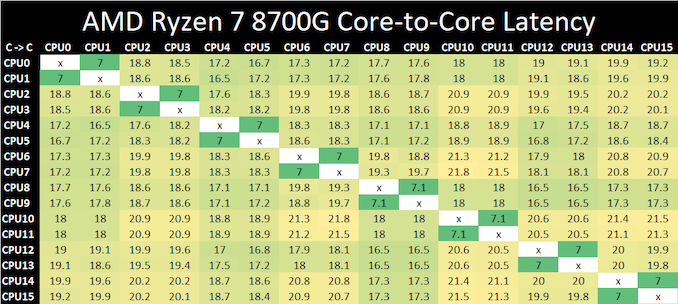AMD Ryzen 7 8700G and Ryzen 5 8600G Review: Zen 4 APUs with RDNA3 Graphics
by Gavin Bonshor on January 29, 2024 9:00 AM EST- Posted in
- CPUs
- AMD
- APUs
- Phoenix
- 4nm
- Zen 4
- RDNA3
- AM5
- Ryzen 8000G
- Ryzen 7 8700G
- Ryzen 5 8600G
Core-to-Core Latency
As the core count of modern CPUs is growing, we are reaching a time when the time to access each core from a different core is no longer a constant. Even before the advent of heterogeneous SoC designs, processors built on large rings or meshes can have different latencies to access the nearest core compared to the furthest core. This rings true especially in multi-socket server environments.
But modern CPUs, even desktop and consumer CPUs, can have variable access latency to get to another core. For example, in the first generation Threadripper CPUs, we had four chips on the package, each with 8 threads, and each with a different core-to-core latency depending on if it was on-die or off-die. This gets more complex with products like Lakefield, which has two different communication buses depending on which core is talking to which.
If you are a regular reader of AnandTech’s CPU reviews, you will recognize our Core-to-Core latency test. It’s a great way to show exactly how groups of cores are laid out on the silicon. This is a custom in-house test, and we know there are competing tests out there, but we feel ours is the most accurate to how quick an access between two cores can happen.
Looking at core-to-core latencies of the AMD Ryzen 7 8700G, as this is a monolithic Phoenix die, we can see good inter-core latencies between each of the eight individual Zen 4 cores. Going within the core, we can see solid latencies of 7ns, while things inter-core range between 17 and 21ns, showing that the Ryzen 7 8700G uses a single core cluster of eight cores.
Similar to what we've seen on previous iterations of Zen 4 and Zen 3, albeit on processors with multiple core complex (CCXs) such as the Ryzen 9 7950 and Ryzen 9 5950X, inter-core latencies are strong and low. In contrast, the Ryzen 7 8700G and other Ryzen 8000G monolithic chips on a single die remove the complications and penalties of connecting through AMD's Infinity Fabric interconnect. The Ryzen 7 8700G uses TSMC's refined 4nm manufacturing process, exactly the same as the Ryzen 7040 mobile, which is coincidentally the exact same design as the 8700G, given that AMD has repurposed Phoenix for use on AMD's AM5 desktop platform.
The core-to-core latency performance is inherently strong on the Ryzen 7 8700G, with low inter-core latencies. As expected, latency degrades a little going across the entire complex, but certainly not within the range where we would expect these penalties to cause latency issues when cores have to communicate with each other.











111 Comments
View All Comments
GeoffreyA - Wednesday, January 31, 2024 - link
On another point, I still think Anand's CPU reviews were better than Ian's. Ian was good but tended to get lost in the details, whereas Anand had an abstraction to his writing, and made computers inspiring, as if you were reading a story. Even the titles were memorable.TheinsanegamerN - Wednesday, January 31, 2024 - link
If you are going by steam, there are nearly as many sub 1080p as there are 1080p gamers. And those sub 1080p users would love the iGPU.If you dont like it, feel free not to read it. Or do your own review if you are so much smarter.
FWhitTrampoline - Tuesday, January 30, 2024 - link
Gamers Nexus has found an Issue with the Ryzen 8000G APUs in the form of some Mobile Variants of the 7000/Phoenix mobile processor firmware settings that should have been removed for the Desktop Ryzen 8000G series Phoenix derivatives. And that has something to do with Laptop/Handheld skin temperature regulation where in order to account for that in laptops/handhelds the processors are being trotted in the Desktop Ryzen 8000G SKUs as if that's in a mobile laptop/handheld from factor device! So watch GN's latest video from today and see that more re-testing may be in order there!nandnandnand - Tuesday, January 30, 2024 - link
It's Skin Temperature Aware Power Management (STAPM).Kinematics - Tuesday, January 30, 2024 - link
The 88 W peak draw is about 25 W above the 65 W TDP, not 35.mikato - Tuesday, January 30, 2024 - link
Are we not doing idle power consumption any more?t.s - Tuesday, January 30, 2024 - link
This depend significantly from PSU and motherboard you're using. anything x70 chipset 24ATX PSU will boost the idle power vs when using x20 and 12VO. But yes, I'm curious too with their setup idle power. My guess, around 50W -> 24ATX 1000W, 6950 GPU.mannen - Tuesday, January 30, 2024 - link
You missed to compare these against the Ryzen 5 7600 and the Ryzen 7 7700 CPUs.That would have been very interesting since they are equivalent (but desktop) parts with the same number of cores/threads. To compare to Ryzen 9 makes no sense since it's not within the same budget class.
I for example am interested in the 8600G, but also looking at the 7600 and keeping my old GPU. Since I don't game a lot, I can easily sacrifice the old GPU but I want to know how much CPU performance I'm giving up.
TheinsanegamerN - Wednesday, January 31, 2024 - link
Well the other commenters here are throwing huge temper tantrums over CPU benchmarks being included in this review, so you may be better off looking elsewhere.lorribot - Tuesday, January 30, 2024 - link
Would have been nice to see a comparison with discrete cards like a RTX2060/3060.